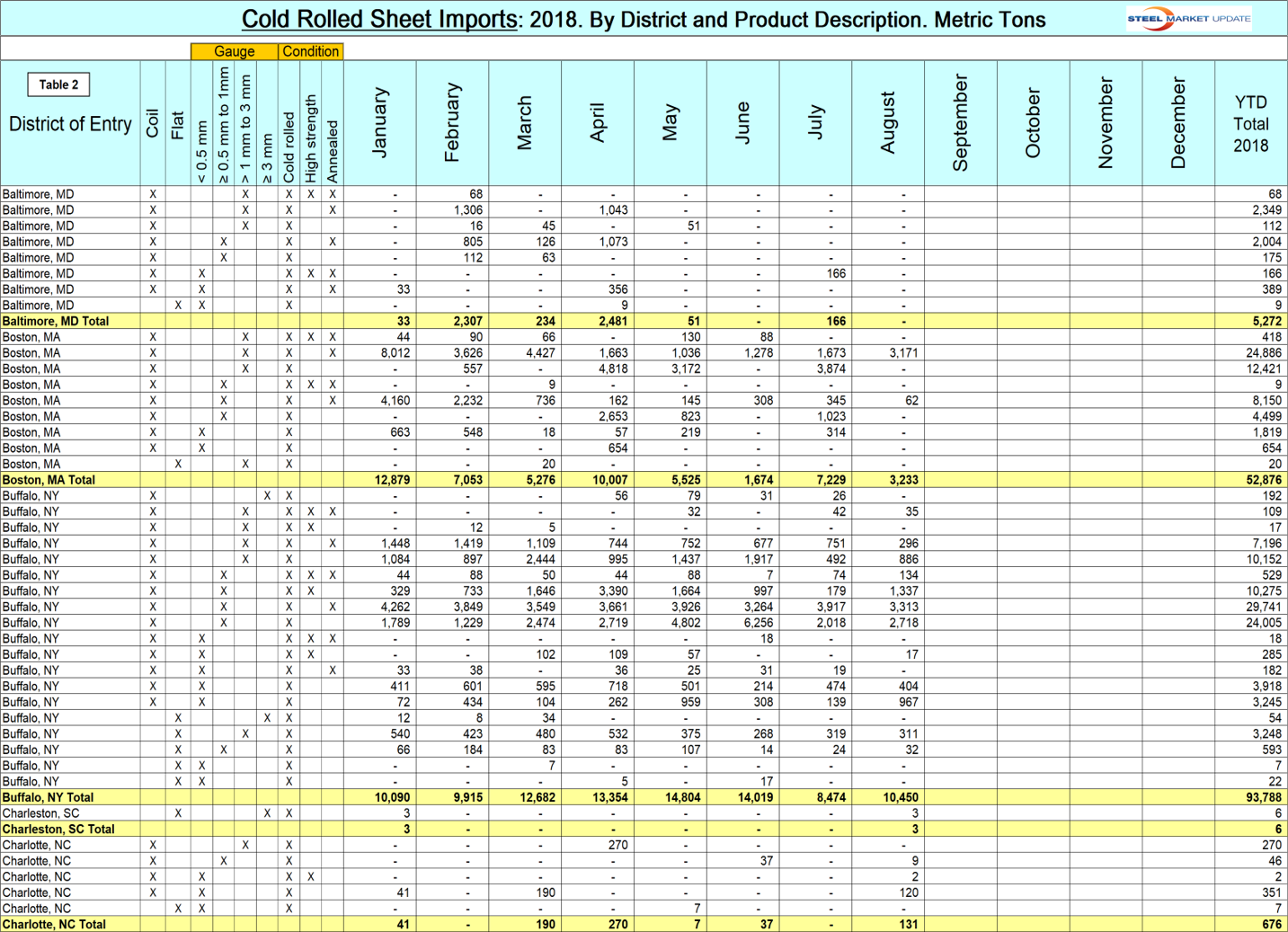SMU Data and Models

SMU Report: CR Sheet Imports by Product Detail Through August
Written by Peter Wright
October 22, 2018
Premium subscribers to Steel Market Update receive reports on imports broken down into district of entry and source nation. This report takes the regional analysis to the level of product detail. Our intent is to report on HR and CR sheet in alternate months in the rationale that the finer the detail steel buyers have about what is coming into their region, the better job they can do of negotiating with suppliers.
Using U.S. International Trade Commission (USITC) data, SMU has taken the import tonnage of cold rolled sheet and broken it down into coil and leveled, then it breaks out four thickness ranges and identifies how much was full hard, annealed and high strength. Finally, this analysis is taken to the district of entry level. Only 0.6 percent of total CR sheet imports are leveled. Total year-to-date sheet and strip imports through June were 1,007,095 and 28,065 metric tons, respectively.
Table 1 is a monthly summary through August and year-to-date 2018 showing gauge range and condition. The total on the first line does not include strip.

Figure 1 breaks the year-to-date cold rolled sheet tonnage down into the four gauge ranges that are identified in the HTS codes. Through August, 21.4 percent was < 0.5 mm, 33.4 percent was ≥ 0.5 mm to 1.0 mm, 44.7 percent was >1.0 to 3.0 mm, and 0.5 percent was > 3.0 mm.

Figure 2 does the same thing for condition. It identifies the volume of full hard, annealed, high strength and high strength annealed. Through August, 48.6 percent was full hard, 41.3 percent was annealed, 4.2 percent was high strength and 5.9 percent was high strength annealed.

Table 2 is a small part of a sheet that shows detail for every region in the U.S. that is available for download here. It shows the product detail of cold rolled sheet imports by district of entry. For example, the highest volume item entering through Detroit is >1 to 3 mm annealed. Another example: If a steel buyer in the Philadelphia region wanted to know how much high strength < 0.5 mm had entered through that district for the year to date, the answer is 16,310 tons, which was the highest volume item into Philadelphia. But there was zero tonnage in July and August.

Note: This data was accessed through the USITC database. All steel traded globally is classified by the Harmonized Tariff System (HTS). The HTS code has 10 digits. The first six are globally universal. The last four are used at the discretion of the nations involved in a particular transaction and are the basis of this report. The way the U.S. uses the last four digits to define products may be different from other nations’ product classifications.

Peter Wright
Read more from Peter WrightLatest in SMU Data and Models

SMU Survey: Sheet lead times ease further, plate hits one-year high
Steel buyers responding to this week’s SMU market survey report a continued softening in sheet lead times. Meanwhile, plate lead times have moderately extended and are at a one-year high.

SMU Survey: Buyers report more price flexibility from mills
Nearly half of the steel buyers responding to this week’s SMU market survey say domestic mills are showing increased willingness to negotiate pricing on new spot orders. This marks a significant shift from the firmer stance mills held in prior weeks.

SMU Survey: Buyers’ Sentiment Indices fall
Current Sentiment Index dropped six points to +42 this week compared to two weeks earlier. It has fallen in every successive survey since reaching a 2025 high of +66 on Feb. 19.

March service center shipments and inventories report
Steel service center shipments and inventories report through March 2024.

Apparent steel supply contracts in February
The amount of finished steel that entered the US market in February receded from January’s peak, according to our analysis of Department of Commerce and American Iron and Steel Institute (AISI) data.
